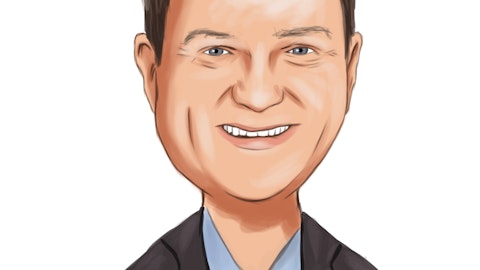Gary Tenner: The largest of the bonus accrual reversal was in the non-GAAP. But in terms of what Amy described as the severance.
Amy Djou: It was offsetting. It was minimal now.
Operator: Our next question comes from Andrew Terrell from Stephens.
Andrew Terrell: Scott, maybe just to go back to some of the competitive dynamics in the multifamily space right now. It obviously sounds pretty tough right now. And I guess I’m just curious how you see the competitive landscape shaping. And specifically, are you seeing competitors kind of reducing capacity across the board in multifamily? And do you think that could have a positive, I guess, eventual impact as you think about the spreads in the business moving forward?
Scott Kavanaugh: Yes. I think as long as the Fed, it provides a lot of uncertainty in the marketplace. You’re going to see people all over the map. I do know that our traditional competitors, I have seen people put out entire departments in the multifamily sector. completely or dramatically slowed down their production. But that being said, there’s almost no volume. I think as Chris was trying to say earlier, a lot of our borrowers, and we’ve talked to a lot of our larger borrowers, they’re not buying. They’re not selling. They’re just kind of sitting back at this particular point, trying to understand what the Fed is going to do and what that might do to cap rates, other types of things.
Joe DePillo: Yes. To your point, I think the competitive landscape in the future is obviously changing somewhat dynamically as these people choose to pull out of the market. Their time to re-up and rehire people should they choose to dip their toe back in or prepare themselves for volume, will make them slow to act relative to how fast we can move to position ourselves back in. But it does take a little bit of, I guess, end client, end customer appreciation for the new rate environment in markets, like California, where I would say the underlying land value is very high. They’re used to a low loan to value versus the debt service that they’re going to get to ultimately get the loan. So I don’t think there’s a huge impact to their willingness and ableness to refinance whereas in other markets, that might be a challenge. But for our primary lending areas, it should not be impactful, and we should be well positioned should rates support the NIM.
Andrew Terrell: Yes. Okay. And just going back to the, I think, $1.5 billion to $2 billion origination target. Can you just help us think about what you’re targeting for the year from an incremental spread standpoint? So just the incremental kind of loan yield less the cost of funding, just understanding the funding costs will probably be elevated. I know it’s probably not great in multifamily, it sounds like right now, but just what’s the incremental spread you’re targeting? And how does that compare to the margin today?
Scott Kavanaugh: Well, the — to the extent that we put more C&I on, currently, those yields are in the 8.5-ish — 8 to 8.5-ish range. Is that right? .
Joe DePillo: Yes.
Scott Kavanaugh: It is. It’s in the 8%, 8.5% range. Incrementally, I would tell you that if we were to put on a borrowing at the Federal Home Loan Bank, that’s somewhere between 4.60, 4.65 currently today. So to the extent that we are successful on rolling over some of those multifamilies, I see those probably going from handles up to 5.5. So by the time you blend some of that stuff, you’re talking mid- to high 6s, I think.
Andrew Terrell: Yes, okay. Got it. That’s helpful. And then if I could just take a stab again at the year-end, either year-end total interest-bearing deposit costs. I think the 1.47 was the full quarter average.
Joe DePillo: Yes, I wanted to…
Scott Kavanaugh: Yes. He was — Joe has been doing giving since Gary you asked that.
Joe DePillo: And I just want to clarify that. So December, the — I misunderstood the question, the spot rate was closer to 2% for December.
Andrew Terrell: And that was the spot rate at the end of December?
Joe DePillo: Yes.
Operator: Our last question comes from Matthew Clark from Piper Sandler.
Matthew Clark: First one for me, just on the lending side of things, the $1.5 billion to $2 billion of production with the potential maybe for an additional $500 million. So let’s just call it, $2 billion I think I recall after pulling kind of your prepay and payoff activity recently, it kind of implies net loan growth of about 10%, call it, 10, 11, 12. Is that kind of in the ballpark in terms of your expectations? Or should we be able to lower that? .
Scott Kavanaugh: Yes. No, you’re correct.
Matthew Clark: Okay. And then in terms of the margin, do you happen to have it for the average margin for the month of December? I feel like we’re in the ballpark, but I just wanted to kind of reaffirm, it kind of looks like your margin might shake on the low 2s this coming quarter.
Scott Kavanaugh: Yes. It’s going to continue to decline. And I think you would be accurate in saying. I think we’re projecting right now 2.15% range to 2.20% range.
Matthew Clark: Okay. Great. And then just on the borrowings, I think you have about $1.5 billion of borrowings at the end of the year. How should we think about those balances throughout the year? I mean, do we kind of just hold at that level based on your actions on the deposit side or not?
Scott Kavanaugh: Yes, it should hold pretty steady there. To the extent that we continue to be successful even if it’s a broker deposit, we will, obviously, pay down the home loan bank, but I don’t really see it expanding much.



